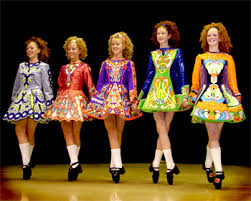Irish Dance
http://en.wikipedia.org/wiki/Irish_dance
Irish Dance and Stuff: From the Beginning of Time…to Yesterday
I grew up Irish dancing and got an awesome job teaching at BYU, and we have a video day once a semester. I took some of the best Irish clips I could find and made them into an educational and (maybe) entertaining video! Hope you enjoy it, and learn something about Irish dance along the way, by Sarah Klopp.
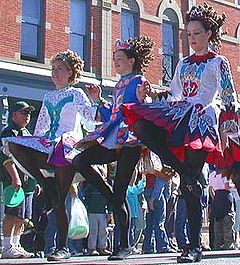 Irish dancers at St. Patrick’s Day parade in Fort Collins, Colorado
Irish dancers at St. Patrick’s Day parade in Fort Collins, Colorado
Irish dancing or Irish dance is a group of traditional dance forms originating in Ireland which can broadly be divided into social dance and performance dances. Irish social dances can be divided further into céilí and set dancing. Irish set dancesare quadrilles, danced by four couples arranged in a square, while céilí dances are danced by varied formations (céilí) of two to sixteen people. In addition to their formation, there are significant stylistic differences between these two forms of social dance. Irish social dance is a living tradition, and variations in particular dances are found across the Irish dancing community; in some places, dances are deliberately modified and new dances are choreographed.
Irish dancing, popularised in 1994 by the world-famous show Riverdance, is notable for its rapid leg and foot movements, body and arms being kept largely stationary.
Most competitive dances are solo dances, though many stepdancers also perform and compete using céilí dances. The solo stepdance is generally characterised by a controlled but not rigid upper body, straight arms, and quick, precise movements of the feet. The solo dances can either be in “soft shoe” or “hard shoe.”
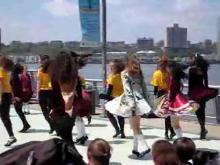 Irish dancers at an Irish Dance Festival in New York City
Irish dancers at an Irish Dance Festival in New York City
The dancing traditions of Ireland probably grew in close association with traditional Irish music. Although its origins are unclear, Irish dancing was later influenced by dance forms from the Continent, especially the Quadrille. Travelling dancing masters taught all over Ireland, as late as the 18th and early 19th centuries. During this time, places for competitions and fairs were always small, so there was little room for the Dance Masters to perform. They would dance on tabletops, sometimes even the top of a barrel. Because of this, the dancing styles were very contained, with hands rigid at the sides, and a lack of arm movement and traveling across the stage. As time went on, larger places for dance competitions and performances were found, so styles grew to include more movement, more dancing across the stage as seen, for example, in Riverdance.
Irish céilí dances
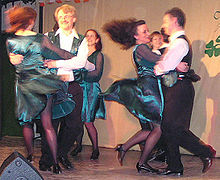 Shramore Set, danced by “Cumann Céilí Vín,” Vienna, Austria
Shramore Set, danced by “Cumann Céilí Vín,” Vienna, Austria
Irish social, or céilí /ˈkeɪli/ dances vary widely throughout Ireland and the rest of the world. A céilí dance may be performed with as few as two people and as many as sixteen. Céilí dances may also be danced with an unlimited number of couples in a long line or proceeding around in a circle (such as in “The Walls of Limerick”, “The Waves of Tory”, “The High Cauled Cap”, “Cross Reel” or “Bonfire Dance”). Céilí dances are often fast and complex. In a social setting, a céilí dance may be “called” – that is, the upcoming steps are announced during the dance for the benefit of newcomers. The céilí dances are typically danced to Irish instruments such as the Irish hand drum or harp.
The term céilí dance was invented in the late 19th century by the Gaelic League. Céilías a noun differs from the adjective céilí. A céilí is a social gathering featuring Irish music and dance. Céilí dancing is a specific type of Irish dance. Some céilithe (plural of céilí) will only have céilí dancing, some only have set dancing, and some will have a mixture.
Irish set dancing
 Irish set dancing (also referred to as “country set dancing”) are dances based on French quadrilles that were adapted by the Irish by integrating their sean-nós steps and Irish music. The distinguishing characteristics of Irish set dancing is that it is danced in square sets of four couples (eight people), and consist of several “figures,” each of which has a number of parts, frequently repeated throughout the set. Each part of the set dance (figure) is danced to a music tempo, mostly reels, jigs, polkas, hornpipes and slides. The sets come from various parts of Ireland and are often named for their place of origin; examples are the Corofin Plain Set, the South Galway Set and the Clare Lancers Set.
Irish set dancing (also referred to as “country set dancing”) are dances based on French quadrilles that were adapted by the Irish by integrating their sean-nós steps and Irish music. The distinguishing characteristics of Irish set dancing is that it is danced in square sets of four couples (eight people), and consist of several “figures,” each of which has a number of parts, frequently repeated throughout the set. Each part of the set dance (figure) is danced to a music tempo, mostly reels, jigs, polkas, hornpipes and slides. The sets come from various parts of Ireland and are often named for their place of origin; examples are the Corofin Plain Set, the South Galway Set and the Clare Lancers Set.
The organisation Comhaltas Ceoltóirí Éireann promotes and hosts many set dance events.
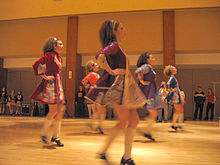 Irish step dancers from Scoil Rince na Connemara in Wilkes-Barre, PA, dance at the HUB, Penn State University. Here, the dancers have their hands on their hips, with their elbows pointed.
Irish step dancers from Scoil Rince na Connemara in Wilkes-Barre, PA, dance at the HUB, Penn State University. Here, the dancers have their hands on their hips, with their elbows pointed.
Stepdancing as a modern form is descended directly from old-style step dancing. There are several different forms of stepdancing in Ireland (including sean-nós dancing and old-style stepdancing), but the style most familiar to the public at large is the Munster, or southern, form, which has been formalised by An Coimisiún le Rincí Gaelacha—the Irish Dancing Commission.
Irish stepdancing is primarily done in competitions, public performances or other formal settings.
Sean-nós dancing in the Irish diaspora
As Irish people emigrate all over the world, they take their cultural traditions with them. Many people theorise that Sean-nós dancing has influenced various other forms of traditional solo dance, especially those found in areas with strong Irish communities. Sean-nós dance likely influenced the development of many American and Canadian traditional percussive dance forms, such as buck dancing, flatfooting, clogging, and tap dancing. Sean-nós dancing in the United States and Canada is most commonly seen at folk festivals, although dance workshops are beginning to introduce the style more widely.
Old-style step dancing is a tradition related to, yet distinct from, sean-nós dancing, though it is sometimes called “Munster-style sean-nós”. Old-style step dancing evolved in the late 18th and early 19th century from the dancing of traveling Irish dance masters. The dance masters slowly formalised and transformed both solo and social dances. Modern masters of old-style step dancing style can trace the lineage of their steps directly back to 18th century dancers.
The Irish dance masters refined and codified indigenous Irish dance traditions. Rules emerged about proper upper body, arm, and foot placement. Also, dancers were instructed to dance a step twice—first with the right foot then with the left. Old-style step dancers dance with arms loosely (but not rigidly) at their sides. They dance in a limited space. There is an emphasis on making percussive sound with the toes. The Irish dance masters of this period also choreographed particular steps to particular tunes in traditional music creating the solo set dances such as the Blackbird, St. Patrick’s Day, and the Job of Journey Work, which also persist in modern Irish stepdancing. In this context, “set dance” signifies a separate tradition from the social dance tradition also called set dance.
Dances
Irish solo stepdances fall into two broad categories based on the shoes worn: hard shoe (or heavy shoe) and soft shoe (or light shoe) dances.
There are four soft shoe dance styles: the reel, slip jig, light jig and single jig (also referred to as hop jig). Reels have a 4/4 (or sometimes 2/4 or 2/2) time signature. Slip jigs are in 9/8 time. Light and single jigs are in 6/8 time, with different emphasis within the measure distinguishing the music. Hard shoe dances include the hornpipe in syncopated 2/4 or 4/4 time, the treble jig (also called the heavy jig or hard jig) in a slow 6/8, the treble reel (heavy dance done to reel music) and traditional sets, which are a group of dances with set music and steps. Many traditional sets have irregular musical phrasing. There are also more advanced “non-traditional sets” done by advanced dancers. These have set music, but not steps. There are multiple traditional sets, including St. Patrick’s Day, Blackbird, Job of Journeywork, Garden of Daisies, and King of the Fairies.
 Competitive dancers generally dance four or six steps at a time, depending on their dancing level. Each step lasts eight bars of music. They are each danced starting with the right foot, then repeated with the left foot. Set dances, however, have a different format. The dancer usually dances one step, which lasts for eight bars of music and is then repeated, resembling the steps of other dances. Then the dancer usually dances a “set,” which lasts for 16 bars of music and is not repeated.
Competitive dancers generally dance four or six steps at a time, depending on their dancing level. Each step lasts eight bars of music. They are each danced starting with the right foot, then repeated with the left foot. Set dances, however, have a different format. The dancer usually dances one step, which lasts for eight bars of music and is then repeated, resembling the steps of other dances. Then the dancer usually dances a “set,” which lasts for 16 bars of music and is not repeated.
The céilí dances used in competitions are more precise versions of those danced in less formal settings. There is a list of 30 céilí dances which have been standardised and published in An Coimisiún’s Ar Rinncidhe Foirne as examples of typical Irish folk dances; these are called the “book” dances by competitive stepdancers. Most Irish dancing competitions only ask for a short piece of any given dance, in the interests of time.
Shoes and costume
There are two types of shoes; soft shoes (also known as ghillies) and hard shoes. Hard shoes are similar to tap shoes, except that the tips and heels are made of fiberglass, instead of metal, and are significantly bulkier. The first hard shoes had wooden or leather taps with metal nails. Later the taps and heels were changed into resin or fiberglass to reduce the weight and to make the sounds louder. The soft shoes, which are called ghillies, are black lace-up shoes. Ghillies are only worn by girls, while boys wear black leather shoes called “reel shoes”, which resemble black jazz shoes with a hard heel. Boy’s soft-shoe dancing features audible heel clicks.
Several generations ago, the appropriate dress for a competition was simply “Sunday best” (clothes one would wear to church). Irish Dance schools generally have school dresses, worn by lower-level competitors and in public performances. As dancers advance in competition or are given starring roles in public performances, they may get a solo dress of their own design and colors. In the 1970’s and 1980’s, ornately embroidered dresses became popular. Today even more ornamentation is used on girls’ dresses. Solo dresses are unique to each dancer. Today most women and girls wear a wig or hairpiece for a competition, but some still curl their own hair. Most men wear a shirt, vest, and tie paired with black trousers.
An organised step dance competition is referred to as a feis (pronounced “fesh”, plural feiseanna). The word feis means “festival” in Irish, and strictly speaking would also have competitions in music and crafts. Féile (/ˈfeɪlə/) is a more correct term for the dance competition, but the terms may be used interchangeably. Dance competitions are divided by age and level of expertise. The names of the levels and other organising rules vary between countries and regions. Dancers are scored based on technique (placement of the feet, turn out, off of their heels, etc.), style (grace, power, etc.) and other items such as timing, rhythm, and sounds in their hard shoe dances.
An annual regional Championship competition is known as an oireachtas (/oʊˈrɒktəs/). An Coimisiún holds various “national” championship competitions. Each of the major Irish step dance organisations hosts a premier championship, going by differing titles. An Coimisiún’s World Championships are the largest, with over 6,000 dancers competing from over 30 countries world-wide.
Oireachtas Rince Na Cruinne, or “The World Championships” (for An Coimisiún dancers), first took place in Dublin in 1970 at Coláiste Mhuire, a school in Parnell Square. The “Worlds” outgrew its original location and moved around the Republic of Ireland and Northern Ireland. In 2002, for the first time, the “Worlds” left Ireland for Glasgow. In 2009, for the first time, the World Championships were held in the United States, in Philadelphia. The 2011 championships were held once again in Dublin. The 2012 championships were held in Belfast, with the 2013–2016 Worlds scheduled for Boston, London, Montréal and Glasgow respectively. The BBC documentary film Jig provided an insight into championship level dancers competing in the 2010 World Championships held in Glasgow.
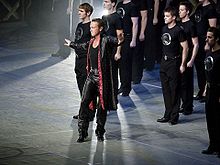 Michael Flatley is credited with bringing Irish dancing to a worldwide audience with his show Riverdance.
Michael Flatley is credited with bringing Irish dancing to a worldwide audience with his show Riverdance.
An Comdhdail’s All Ireland and International championships takes place each Easter week, with the competition being held in Ennis in 2011. The largest NAIDF (North American Irish Dance Federation) competition currently is The Nationals held at Lehigh University in Bethlehem, Pennsylvania, in 2010, and at The Valley Forge Convention Center in Pennsylvania in 2012. The WIDA (World Irish Dance Association), which is mainly dancers from European countries, also hold their own World and European Championships over the Easter week, with the competition being held in Berlin in 2011, and scheduled for Poland in 2012. Flatley then came out with Feet of Flames, which is a show similar to Riverdance.


